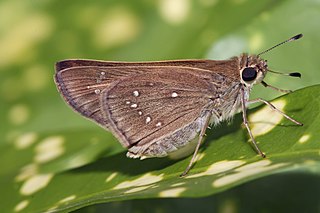Related Research Articles

Skippers are a family of the Lepidoptera named the Hesperiidae. Being diurnal, they are generally called butterflies. They were previously placed in a separate superfamily, Hesperioidea; however, the most recent taxonomy places the family in the superfamily Papilionoidea. They are named for their quick, darting flight habits. Most have their antenna tips modified into narrow, hook-like projections. Moreover, skippers mostly have an absence of wing-coupling structure available in most moths. More than 3500 species of skippers are recognized, and they occur worldwide, but with the greatest diversity in the Neotropical regions of Central and South America.

Tyta luctuosa is a noctuid ("owlet") moth. Its common names include four-spotted moth and field bindweed moth. It is the only member of the genus Tyta, which forms a hitherto monotypic tribe Tytini in the Catocalinae subfamily. The species was first described by Michael Denis and Ignaz Schiffermüller in 1775. The genus was erected by Gustaf Johan Billberg in 1820 and the tribe was described by Herbert Beck in 1996.

Digama is a genus of moths in the family Erebidae described by Frederic Moore in 1858. It is distributed in South Africa, China, throughout India, Sri Lanka, Myanmar and Australia.

The cloaked minor(Mesoligia furuncula) is a moth of the family Noctuoidea. It is found in the Palearctic realm (Europe, northwest Africa, Russia, Siberia, Japan, north Iran, Afghanistan, and China.
Lomuna is a monotypic moth genus in the subfamily Arctiinae erected by William D. Field in 1952. Its single species, Lomuna nigripuncta, was first described by George Hampson in 1900. It is found in Puerto Rico and Colombia.

Perispasta is a genus of moths of the family Crambidae. It contains only one species, Perispasta caeculalis, or Titian Peale's pyralid moth, which is found in North America, where it has been recorded from Quebec west to British Columbia, south to Florida, Texas and Colorado. The habitat consists of fields and meadows. Both the genus and species were first described by Philipp Christoph Zeller in 1875.

Hypenodes is a genus of moths of the family Erebidae erected by Henry Doubleday in 1850.

Pterapherapteryx is a monotypic moth genus in the family Geometridae erected by John Curtis in 1825. Its only species, Pterapherapteryx sexalata, the small seraphim, was first described by Anders Jahan Retzius in 1783. It is found in central and northern Europe and south-east Russia.
Phanoschista is a genus of moths in the family Lecithoceridae. It contains the species Phanoschista meryntis, which is found in southern India.

Sterrhinae is a large subfamily of geometer moths with some 3,000 described species, with more than half belonging to the taxonomically difficult, very diverse genera, Idaea and Scopula. This subfamily was described by Edward Meyrick in 1892. They are the most diverse in the tropics with the number of species decreasing with increasing latitude and elevation.
Agathiphaga vitiensis, or the Fiji kauri moth, is a moth of the family Agathiphagidae. It is found from Fiji to Vanuatu and Solomon Islands.
Heterocrossa ignobilis is a species of moth in the family Carposinidae. It is endemic to New Zealand.

Cahela is a monotypic snout moth genus described by Carl Heinrich in 1939. Its only species, Cahela ponderosella, the cahela moth, described by William Barnes and James Halliday McDunnough in 1918, is found in Mexico and in the US states of California, Texas, Arizona, Utah and probably Nevada.
Paramulona albulata is a moth in the subfamily Arctiinae first described by Gottlieb August Wilhelm Herrich-Schäffer in 1866. It is found on Cuba. There is also a record from Puerto Rico, but this is probably a misidentification.
Epeiromulona biloba is a moth of the subfamily Arctiinae. It was described by William D. Field in 1952. It is found in Panama and Colombia.
Epeiromulona hamata is a moth of the subfamily Arctiinae. It was described by William D. Field in 1952. It is found in Trinidad, northern South America and Brazil.
Epeiromulona icterinus is a moth of the subfamily Arctiinae. It was described by William D. Field in 1952. It is found in Guatemala and Panama.
Epeiromulona lephina is a moth of the subfamily Arctiinae. It was described by William D. Field in 1952. It is found in Panama and Guatemala.
Epeiromulona phelina is a moth of the subfamily Arctiinae. It was described by Druce in 1885. It is found in Panama.

Epeiromulona thysanata is a moth of the subfamily Arctiinae. It was described by William D. Field in 1952. It is found in French Guiana, Guyana, Suriname, Costa Rica and Panama.
References
- ↑ Field, William D. (1952). "Moths of the Genus Epeiromulona, a New Genus of Lepidoptera" (PDF). Proceedings of the United States National Museum. 102 (3308): 455–469. doi:10.5479/si.00963801.102-3308.455.
- Pitkin, Brian & Jenkins, Paul. "Search results Family: Arctiidae". Butterflies and Moths of the World. Natural History Museum, London.
| This Lithosiini-related article is a stub. You can help Wikipedia by expanding it. |